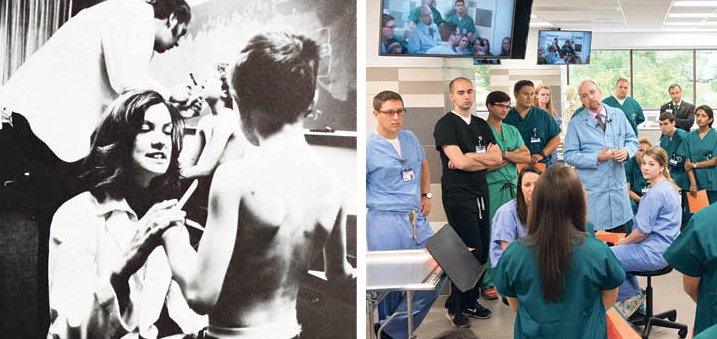Heritage College of Osteopathic Medicine: So much history in only 40 years!
Ohio University officials first discussed the possibility of starting a medical college in 1823. The trustees even set aside land for the project.
By Jim Phillips, BSJ ’88, communications specialist, Heritage College | November 18, 2015
Share:

“Osteopathy, a rapidly growing branch of medicine, involves itself with every aspect of health care,” reports the 1978 Spectrum Green yearbook. “While 80 percent of the M.D.s nationwide are specialists, 75 percent of the D.O.s nationwide are involved in family practice.” In that year, approximately 15,000 students applied to the program, the yearbook stated. Now, OHIO offers three campuses to train the next generation of D.O.s—in Athens, Dublin, and, in this photo, the brand-new location in Cleveland. Photo by Joel Prince, BSVC ’12.
Did you know the following about the Heritage College?
- Ohio University officials first discussed the possibility of starting a medical college in 1823. The trustees even set aside land for the project, on the College Green. Today, a plaque commemorates the site.
- Ohio Osteopathic Association House of Delegates formed a committee in 1972 on the feasibility of an osteopathic college in the state, which had only M.D. schools.
- The 1975 law creating the Ohio University College of Osteopathic Medicine specified that 80 percent of its students be from Ohio or commit to practicing in the state for five years after graduation. This requirement helped garner legislative support.
- When the college opened in 1976 under first dean Gerald Faverman, Ph.D., Ohio ranked third among U.S. states for its number of practicing D.O.s—despite having no osteopathic medical college. There were only nine in the country then; now there are 31.
- The year the college opened, then-U.S. President Gerald Ford warned, “The country is facing two growing problems: There are not enough doctors in rural and inner-city areas, and there is a continuing decline in the number of doctors practicing primary care.”
- The oldest member of Heritage College’s first class was 33 when he started medical college—switching gears after years as a military fighter pilot. Other students that inaugural year, according to the 1977 medical college yearbook: “a Ph.D. in immunology, a flight attendant, a drug salesman, a pharmacist, a Peace Corps volunteer, and many people with advanced degrees or experience in a medical field.”
- The new institution faced opposition from the chancellor of the Ohio Board of Regents as well as from the Cleveland Plain Dealer , which argued that enough state money was being spent to ensure an adequate supply of family physicians through existing Ohio medical schools. The Athens Messenger countered by noting that across 17 southeast Ohio counties, there were more than 1,350 residents for every practicing physician.
- The first class graduated in 1980 under second dean, Frank Myers, D.O., now trustee professor emeritus of family medicine, who would lead the school for 16 years, help develop a statewide network of affiliated teaching hospitals, and increase enrollment to 100 new students.
- The college made history in August 1993 by naming Barbara Ross-Lee, D.O., dean to replace Myers. Ross-Lee, sister of Motown superstar Diana Ross, was the first African American woman to head a U.S. medical school.
- The Osteopathic Heritage Foundations announced in April 2011 a $105 million award to the medical college—at the time, the largest private donation ever given to a college or university in Ohio. College and Foundation officials said the gift would be used to address the impending shortage of primary care physicians and the diabetes epidemic. To recognize the gift, the Ohio University Trustees approved changing the college’s name to the Ohio University Heritage College of Osteopathic Medicine.
- The first class of 50 medical students arrived for classes at the Heritage College, Dublin, in July 2014. This additional cohort of students gave the school its largest incoming class ever, of 190 students.
- The first class of 51 medical students began their studies at the Heritage College, Cleveland, in July 2015. Once again, the school set a record for incoming class size, with 240 students.
- As of January 2015, the Heritage College counted more than 3,000 alumni, with nearly 2,400 practicing. Of those in practice, 48 percent were in primary care fields; 58 percent were in Ohio; and 34 percent were in areas designated by the federal government as medically underserved.


